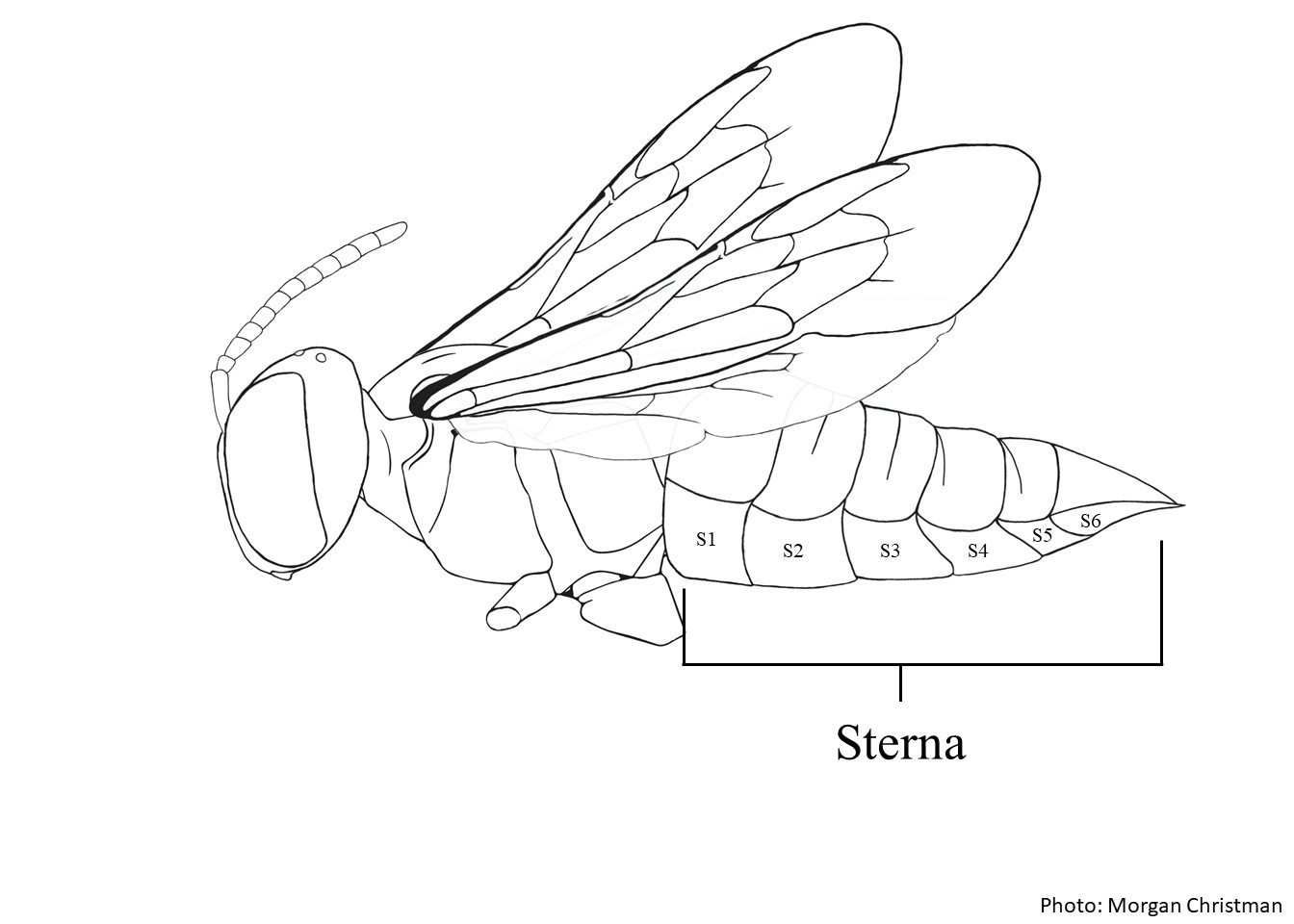Family: Apidae
Subfamily: Xylocopinae
Tribe: Ceratinini
Genus: Ceratina Latreille, 1802
Subgenus: Ctenoceratina Daly and Moure, 1988
Common name: small carpenter bees
Ceratina (Ctenoceratina) have black integumentintegument:
a tough, protective outer layer
, occasionally with metallic reflections, and pale markings limited to the head, pronotal lobes, and legs. Their body length varies between 5–9 mm (Michener 2007Michener 2007:
Michener, C.D. 2007. The Bees of the World (2nd ed.). Johns Hopkins University Press, Baltimore and London, 953 pp.).
(modified from Daly 1988Daly 1988:
Daly, H.V. 1988. Bees of the new genus Ctenoceratina in Africa south of the Sahara (Hymenoptera: Apoidea). University of California Publications in Entomology 108: 1ndash;66.; Michener 2007Michener 2007:
Michener, C.D. 2007. The Bees of the World (2nd ed.). Johns Hopkins University Press, Baltimore and London, 953 pp.)
 area above the antennal socket distinctly punctatepunctate:
area above the antennal socket distinctly punctatepunctate:Ceratina (Ctenoceratina) may be confused with species in C. (Simioceratina), because they both have apicalapical:
near or at the apex or end of any structure
rows of coarse, sometimes scale-like setaesetae:
a still hair-like structure or bristle
on T2T2:
the segments on the top side of the abdomen, often abbreviated when referring to a specific segment to T1, T2, T3, T4, T5, T6, or T7 to T5T5:
to T5T5:
the segments on the top side of the abdomen, often abbreviated when referring to a specific segment to T1, T2, T3, T4, T5, T6, or T7 , and S2S2:
, and S2S2:
the plates on the underside of the abdomen, often abbreviated when referring to a specific segment to S1, S2, S3, S4, S5, S6, S7, or S8
 to S5S5:
to S5S5:
the plates on the underside of the abdomen, often abbreviated when referring to a specific segment to S1, S2, S3, S4, S5, S6, S7, or S8
 . However, unlike Simioceratina, Ctenoceratina's scutellumscutellum:
. However, unlike Simioceratina, Ctenoceratina's scutellumscutellum:
shield shaped plate behind scutum slopes less abruptly to join the sloping metanotummetanotum:
the posterior dorsal segment of the thorax, behind the scutellum
and propodeumpropodeum:
the last segment of the thorax
(Eardley et al. 2010Eardley et al. 2010:
Eardley, C., M. Kuhlmann, and A. Pauly. 2010. The Bee Genera and Subgenera of sub-Saharan Africa. Abc taxa 7: 1-145.).
Ceratina (Ctenoceratina) armata has been observed visiting the plant families Aizoaceae and Fabaceae (Ascher and Pickering 2020Ascher and Pickering 2020:
Ascher, J.S. and J. Pickering. 2020. Discover Life bee species guide and world checklist (Hymenoptera: Apoidea: Anthophila). https://www.discoverlife.org/mp/20p?see=Carinulaamp;name=Megachileamp;flags=subgenus :).
Females excavate nesting burrows in dead stems of a variety of plants. Normally, a single adult female is found in a nest, but occasionally two females can be present in one nest with brood, particularly in C. moerenhouti. Although a few adult female and male bees may be found together in empty nests during inactive seasons, they do not form large aggregations (Daly 1988Daly 1988:
Daly, H.V. 1988. Bees of the new genus Ctenoceratina in Africa south of the Sahara (Hymenoptera: Apoidea). University of California Publications in Entomology 108: 1ndash;66.).
Ceratina (Ctenoceratina) contains ten species (Daly 1988Daly 1988:
Daly, H.V. 1988. Bees of the new genus Ctenoceratina in Africa south of the Sahara (Hymenoptera: Apoidea). University of California Publications in Entomology 108: 1ndash;66.).
There are no known invasives.
Ctenoceratina is widespread in Africa, south of the Sahara, from Senegal to Ethiopia, all the way down to South Africa (Michener 2007Michener 2007:
Michener, C.D. 2007. The Bees of the World (2nd ed.). Johns Hopkins University Press, Baltimore and London, 953 pp.).

Distribution map generated by Discover Life -- click on map for details, credits, and terms of use.
Daly, H.V. 1988. Bees of the new genus Ctenoceratina in Africa south of the Sahara (Hymenoptera: Apoidea). University of California Publications in Entomology 108: 1–66.
Eardley, C., M. Kuhlmann, and A. Pauly. 2010. The Bee Genera and Subgenera of sub-Saharan Africa. Abc taxa 7: 1-145.
Michener, C.D. 2007. The Bees of the World (2nd ed.). Johns Hopkins University Press, Baltimore and London, 953 pp.